Call for demos at ICRA40
We are excited to provide an extraordinary opportunity for researchers to showcase your cutting-edge robotic research through live demonstrations at the Expo of ICRA@40, Rotterdam, Netherlands from Sept 23 – 26, 2024

China

Handheld Multi-Functional 3D Scanner: Portable Solution for Mobile Mapping and Navigation
Short abstract of demo:
This innovative handheld 3D scanner offers high-precision mapping for diverse indoor/outdoor environments. Featuring multiple sensors, FPGA-based synchronization, and advanced positioning algorithms, it enables real-time localization and 3D point cloud mapping. Adaptable to various robotic platforms, it supports large-scale scene reconstruction, providing key technology for VR/AR, digital twins, and autonomous navigation.
Presenters:
Xiangcheng Hu, Da Zhang
University:
The Hong Kong University of Science and Technology

Belgium

ROB-ID for robotic vaccination in the pharmacy of the future
Short abstract of demo:
Vaccination is shifting more and more to pharmacies and health centers. Pharmacists are getting an extended role as part of a healthcare provider team, increasing their workload. ROB-ID, a vaccination robot, equipped with VAX-ID, a device for skin drug delivery, was developed to unload pharmacists, embodying the Pharmacy of the Future.
Presenters:
Koen Beyers, Vanessa Vankerckhoven
University:
Stemberg BV, Idevax BV, University of Ghent

Germany
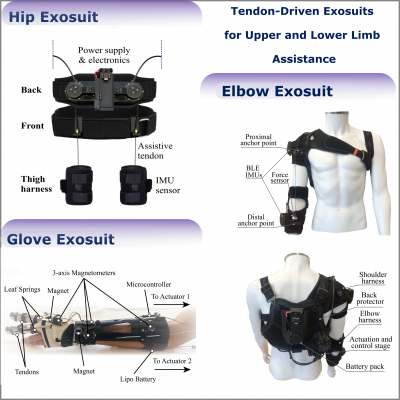
Tendon-Driven Exosuits for Upper and Lower Limb Assistance
Short abstract of demo:
Soft exosuits represent a recent advancement in wearable robotics, offering a unique blend of flexibil- ity and functionality to enhance human performance. These lightweight, fabric-based exoskeletons are designed to seam- lessly integrate with the wearer’s body, providing support and assistance to specific muscle groups without the bulkiness associated with traditional exoskeletons. The primary goal of soft exosuits is to augment human capabilities, whether in the realm of rehabilitation, industrial applications, or enhancing athletic performance. During the upcoming demonstration, we will show our latest innovations in exosuit technology
Presenters:
Francesco Missiroli, Enrica Tricomi, Federico Masiero, Lorenzo Masia
University:
Heidelberg University

Germany
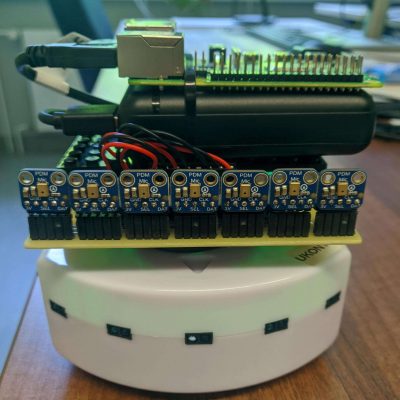
RO-BAT: Navigating space using sound-driven directional awareness
Short abstract of demo:
RO-BAT is a bio-inspired robot designed for obstacle avoidance using auditory cues. Unlike traditional robots relying on visual or proximity sensors, RO-BAT autonomously navigates by detecting sound-emitting obstacles. It employs a microphone array to estimate the direction of sound sources, integrating this data with its motor control system for real-time navigation.
Presenters:
Alberto Doimo, Sindiso Mkhatshwa, Simay Atasoy
University:
University of Konstanz, Centre for the Advanced Study of Collective Behaviour

Luxembourg

Interactive Robotic Manipulation in Simulated Space Environments
Short abstract of demo:
Robotics plays a crucial role in the future of space exploration, with an increasing emphasis on contact-rich manipulation for assembling and maintaining orbital structures and planetary outposts. This demonstration allows participants to teleoperate robots in simulated space environments to experience the challenges of extraterrestrial conditions.
Presenters:
Andrej Orsula, Miguel Olivares-Mendez, Carol Martinez
University:
University of Luxembourg

Italy
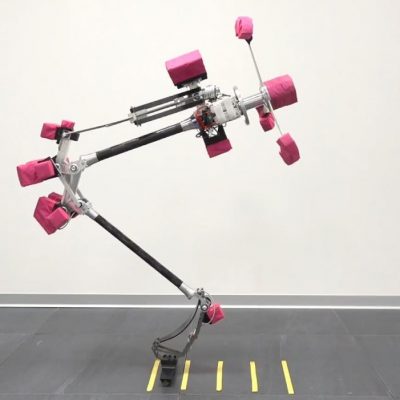
Balancing With a Monopedal Robot
Short abstract of demo:
This demo presents Skippy, a prototype of a human-sized, untethered athletic hopping and balancing underactuated monopedal robot designed to withstand crash landings. During the demo, the robot will dynamically balance on its foot, which is an unstable contact point in 2D (see video link). Furthermore, this demo will be interactive, and the audience can push/play with the robot, which will fall or recover if it’s within its capabilities.
Presenters:
Federico Allione, Antonios E. Gkikakis
University:
Department of Advanced Robotics, Istituto Italiano di Tecnologia

Spain
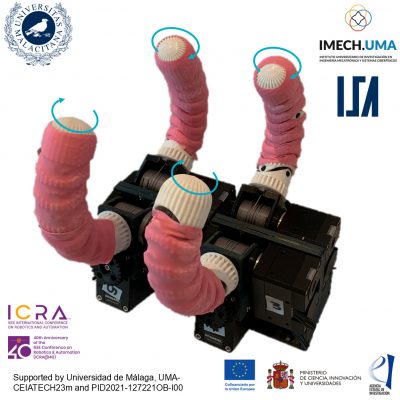
Augmented manipulation skills of adaptive grippers with active rolling fingers for pHRI and industry
Short abstract of demo:
This demo showcases the manipulation skills of a novel gripper with 2-DoFs adaptive underactuated fingers. While the first one controls the conventional opening and closing of the fingers, the second confers each finger’s additional axial rotation motion. Compared to other robotic grippers, this extra DoF augments its manipulation skills and allows for single-arm and single-grasp tasks that usually require multi-grasping, bimanual manipulation, or complex planning and control strategies. This design is particularly beneficial for physical human-robot interaction, particularly for human limb manipulation, as shown in this demo. Two showcases are presented to demonstrate the gripper’s capabilities: manipulation of everyday objects and sleeve rolling, which is a common task in nursing and first response environments, where direct access to the skin of the distal forearm of the human is needed to measure vital signals or perform medical procedures.
Presenters:
Jesús M. Gómez-de-Gabriel and Juan M. Gandarias
University:
University of Malaga

The Netherlands
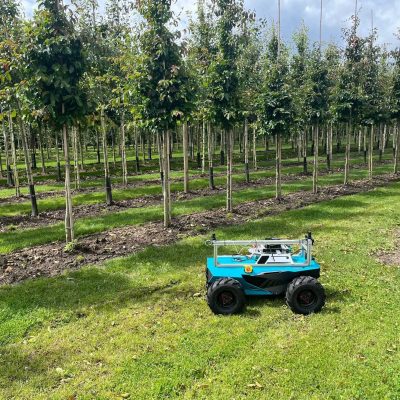
The RAAK-MKB Autonomous Agricultural Navigation (AAN) Project
Short abstract of demo:
The Autonomous Agricultural Navigation project was a project of five Dutch pioneering robot builders that, together with Asimovo and Saxion University of Applied Sciences, have developed autonomous behaviors using the ROS 2 and Nav2 frameworks. The demonstration shows the Asimovo platform which was used for research, development and collaboration between partners during the project.
Presenters:
Christine Fraser Boer, Kees van Teeffelen, Benjamin van Manen, Ayham Alharbat
University:
Saxion University of Applied Sciences

United Kingdom

Using Soft and Haptic Robots to Simulate Diagnostic Procedures for Medical Students
Short abstract of demo:
Physical examination of a patient by a doctor is an intensely dexterous, tactile skill. Medical students must learn to explore the hardness and shape of organs by pressing through the skin, identify the textural features of skin lesions and characterise abnormal pulses by detecting the rise and fall of a physical beat. This demonstration presents a suite of haptic and robotic technologies developed in collaboration with the Imperial College School of Medicine to realistically simulate these procedures so that medical students can learn and practice these essential skills in realistic, low-risk and highly instrumented environments. This demonstration will present haptic and robotic simulations of five physical examinations taught in the UK undergraduate medical curriculum and specialist pathway training.
Presenters:
Joshua Brown, Zumeng Liu, Prateek Sunkavalli
University:
Imperial College London

Italy

A Curious Head: child-inspired cognitive architecture for robot’s autonomous learning.
Short abstract of demo:
Robots in social contexts must adapt to their environment and social dynamics. We demonstrate iCub head robot equipped with a cognitive architecture enabling the collection and learning from unsupervised experiences autonomously. The demo also introduces the iCube, a sensorized cube to assess adults’ and children’s object manipulation skills.
Presenters:
Omar Eldardeer, Luca Garello, and Giulia Belgiovine
University:
Italian Institute of Technology

Germany
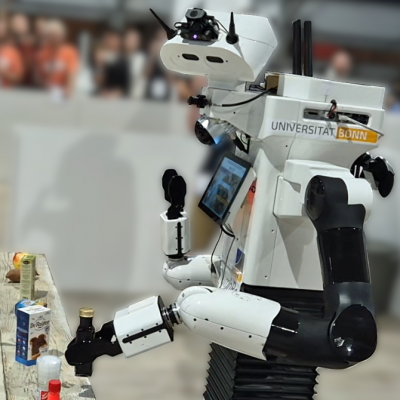
Vision Language Models Embodied in the RoboCup@Home 2024 Winning Service Robot - An Interactive Demonstration
Short abstract of demo:
Based on our Team NimbRo’s winning finals demonstration at RoboCup@Home 2024 in Eindhoven, we present the integration of vi- sual and auditory perception, mobile manipulation, and navigation with an LLM-based agent framework. It is capable of planning and executing a wide range of tasks provided by non-expert human operators. Thus, our demonstration invites visitors to verbally interact with our robot to solve common household tasks, such as gathering and communicating in- formation about its environment, discussing tasty and feasible recipes, or gathering ingredients to prepare a meal.
Presenters:
Bastian Pätzold, Jan Nogga, Raphael Memmesheimer
University:
Autonomous Intelligent Systems – University of Bonn

The Netherlands
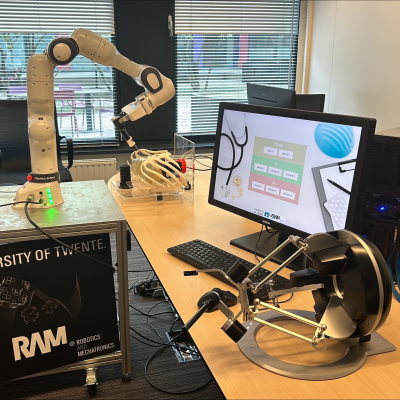
Teleoperation Setup for Hepatic Needle Insertions with Haptic Feedback and Visualization Technologies
Short abstract of demo:
This demonstration showcases a teleoperation system designed for hepatic needle insertions using a robotic arm, integrated with an innovative haptic feedback system featuring viscosity control and independent forward/lateral control. The setup offers immersive visualization through an autostereoscopic 3D (glassless) display and augmented reality (AR) headset. A comparative study evaluates how these display technologies impact procedural efficiency and user experience, focusing on reducing procedure time and enhancing usability. Attendees can interact with the system in two configurations: with the robotic arm performing needle insertions into a phantom model or in a simulated mode without needle actuation. This demo emphasizes the role of display technology in improving the precision and usability of percutaneous teleoperation procedures.
Presenters:
Nick van Lange, Momen Abayid, Mostafa Selim, Sander Smits
University:
University of Twente

Germany
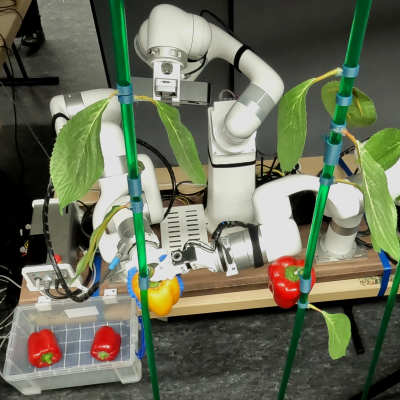
Demonstration of Sweet Pepper Harvesting using HortiBot, a Dual-Arm Manipulation System with Active Perception
Short abstract of demo:
HortiBot is a three-armed system, used for sweet pepper harvesting in the glasshouse. It has a dual-arm manipulation system along with a third arm as an articulated head for active mapping and fruit following using stereo cameras. The right arm performs adaptive soft grasping while the left arm cuts the peduncle.
Presenters:
Christian Lenz, Rohit Menon, Michael Schreiber
University:
University of Bonn

The Netherlands
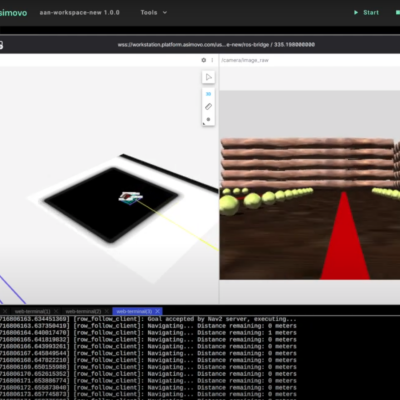
Autonomous Agricultural Navigation
Short abstract of demo:
Demonstration of Autonomous Navigation of a Agricultural Rover. Three distinct navigation behaviours are demonstrated.
Presenters:
Kees van Teeffelen, Ayham Alharbat, Benjamin van Manen
University:
Saxion University

Chile
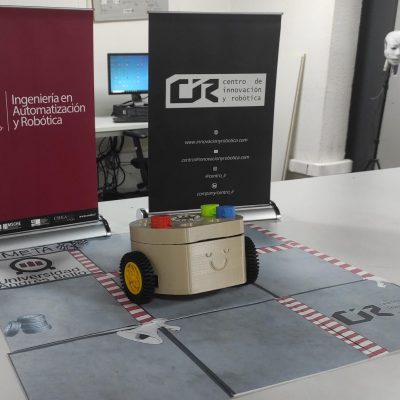
Predubot: an on-board programmable robot for pre-schoolers
Short abstract of demo:
This demonstration showcases a teleoperation system designed for hepatic needle insertions using a robotic arm, integrated with an innovative haptic feedback system featuring viscosity control and independent forward/lateral control. The setup offers immersive visualization through an autostereoscopic 3D (glassless) display and augmented reality (AR) headset. A comparative study evaluates how these display technologies impact procedural efficiency and user experience, focusing on reducing procedure time and enhancing usability. Attendees can interact with the system in two configurations: with the robotic arm performing needle insertions into a phantom model or in a simulated mode without needle actuation. This demo emphasizes the role of display technology in improving the precision and usability of percutaneous teleoperation procedures.
Presenter:
Miguel A. Solis
University:
Universidad Andres Bello and Centro de Innovacion y Robotica (NGO)

Germany
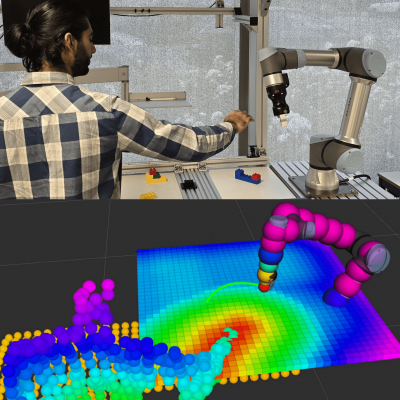
Safe Human-Robot Interactions with Continuous and Differentiable Distance Fields - Interactive Live Demo with UR3e Robot
Short abstract of demo:
Human-robot collaboration demands safety and reactive planning. This demo showcases our Gaussian Process distance field framework integrated with Riemannian Motion Policies for safe and dynamic interactions. Participants can influence an UR3e robot’s trajectory, exploring its responsiveness and safety in real time.
Presenters:
Usama Ali, Adrian Müller, Prof. Dr. Tobias Kaupp
University:
Technical University of Applied Sciences Würzburg-Schweinfurt
ICRA@40 is a special symposium commemorating 40 years of the founding of the IEEE Robotics and Automation Society (RAS) and the launch of ICRA, the largest conference in robotics.
Selected demonstrators will receive up to 2.5K Euros in travel support.
In addition, all teams with a demonstration will receive a complimentary registration for up to three team members.
Submission Process
Please submit your demonstration proposal as a single-page PDF document. The proposal should include the following details:
• Title of the Demonstration: Clearly indicate the title of your demo.
• Demonstrators’ Names & Affiliations: List all presenters’ names and institutional affiliations.
• Abstract: Provide a brief abstract summarizing the demo, including its key features.
• Video Link: Include a link to a video showcasing the demo or related content.
• Hardware Description: Describe the hardware components, including details such as the robot’s size and any specific technical aspects.
• Space Requirements: Specify the space needed for the demonstration (in square meters), i.e., Small (4 m2), Medium (9 m2), or Large (18 m2).
• Paper ID: If this demo is associated with a paper accepted at ICRA@40, please include the Paper ID.
• Additional Information: Include any other relevant information that may assist in the evaluation of your proposal.
Please submit your Demo proposals to demos-icra40@ieee.org
Note: please be aware that demonstrations shown at ICRA40 will be filmed and photographed for promotional and documentation purposes.
Equipment provided for the Demos
Each demo will be provided with the following equipment:
• Power plugs (AC 230V, 5 number of plugs)
• One TV screen (55’ HMDI ).
• Tables (1 for small and medium demos, 2 tables for larger demos)
• 2 chairs per table
• Storage for the pallets/boxes
Schedule
The duration of the demonstrations at the ICRA@40 expo is 4 days (Sept 23-26).
Note: Please let us know in the application if you have any restrictions on the suggested duration of the demos.



